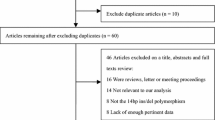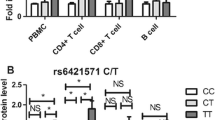Abstract
Human leukocyte antigen (HLA)-E can contribute to the escape of cancer cells from host immune mechanisms. However, it is unknown whether HLA-E gene polymorphisms might play a role in cancer immune escape. This study aimed to evaluate the correlation between HLA-E gene polymorphisms and HLA-E expression in tumor tissue and determine the effects on clinical outcome of patients with stage III colorectal cancer. Two hundred thirty patients with stage III colorectal cancer were enrolled. HLA-E expression was detected in patient-derived tumor tissues with immunohistochemistry. HLA-E gene alleles in tumor tissues were detected with the polymerase chain reaction–sequence-specific primer method. In colorectal cancer tissue and in the normal tissue adjacent to the tumor, the HLA-E expression rates were 72.2 and 15.1 %, respectively (P < 0.05). Patients with overexpression, low expression, and no expression of HLA-E exhibited disease-free survival of 55.3, 72.9, and 72.1 %, respectively. Patients with HLA-E overexpression exhibited the lowest long-term survival rate. No relationship was observed between the type of HLA-E gene polymorphism and its expression level in tumor tissues; moreover, no polymorphisms appeared to affect the long-term survival of patients with colorectal cancer. The type of HLA-E polymorphism did not have an impact on HLA-E expression in tumors or the prognosis in patients with stage III colorectal cancer. However, the level of HLA-E expression in tumor tissue strongly predicted long-term survival in these patients.





Similar content being viewed by others
References
Golfinopoulos V, Salanti G, Pavlidis N, et al. Survival and disease-progression benefits with treatment regimens for advanced colorectal cancer: a meta-analysis. Lancet Oncol. 2007;8(10):898–911.
Morris EJ, Maughan NJ, Forman D, et al. Identifying stage III colorectal cancer patients: the influence of the patient, surgeon, and pathologist. J Clin Oncol. 2007;25(18):2573–9.
Iinuma H, Watanabe T, Mimori K, et al. Clinical significance of circulating tumor cells, including cancer stem-like cells, in peripheral blood for recurrence and prognosis in patients with Dukes’ stage B and C colorectal cancer. J Clin Oncol. 2011;29(12):1547–55.
Bernal M, García-Alcalde F, Concha A, et al. Genome-wide differential genetic profiling characterizes colorectal cancers with genetic instability and specific routes to HLA class I loss and immune escape. Cancer Immunol Immunother. 2012;61(6):803–16.
Kim R, Emi M, Tanabe K. Cancer immunoediting from immune surveillance to immune escape. Immunology. 2007;121(1):1–14.
Palmisano GL, Contardi E, Morabito A, et al. HLA-E surface expression is independent of the availability of HLA class I signal sequence-derived peptides in human tumor cell lines. Hum Immunol. 2005;66(1):1–12.
Petrie EJ, Clements CS, Lin J, et al. CD94-NKG2A recognition of human leukocyte antigen (HLA)-E bound to an HLA class I leader sequence. J Exp Med. 2008;205(3):725–35.
Wischhusen J, Friese MA, Mittelbronn M, et al. HLA-E protects glioma cells from NKG2D-mediated immune responses in vitro: implications for immune escape in vivo. J Neuropathol Exp Neurol. 2005;64(6):523–8.
Bossard C, Bézieau S, Matysiak-Budnik T, et al. HLA-E/β2 microglobulin overexpression in colorectal cancer is associated with recruitment of inhibitory immune cells and tumor progression. Int J Cancer. 2012;131(4):855–63.
Grimsley C, Ober C. Population genetic studies of HLA-E: evidence for selection. Hum Immunol. 1997;52(1):33–40.
O’Callaghan CA, Bell JI. Structure and function of the human MHC class Ib molecules HLA-E, HLA-F and HLA-G. Immunol Rev. 1998;163:129–38.
Arnaiz-Villena A, Vargas-Alarcon G, Serrano-Vela JI, et al. HLA-E polymorphism in Amerindians from Mexico (Mazatecans), Colombia (Wayu) and Chile (Mapuches): evolution of MHC-E gene. Tissue Antigens. 2007;69(Suppl 1):132–5.
Matte C, Lacaille J, Zijenah L, et al. HLA-G and HLA-E polymorphisms in an indigenous African population. The ZVITAMBO Study Group. Hum Immunol. 2000;61(11):1150–6.
Veiga-Castelli LC, Castelli EC, Mendes CT Jr, et al. Non-classical HLA-E gene variability in Brazilians: a nearly invariable locus surrounded by the most variable genes in the human genome. Tissue Antigens. 2012;79(1):15–24.
Kunisada T, Moseley JM, Slavin JL, et al. Co-expression of parathyroid hormone-related protein (PTHrP) and PTH/PTHrP receptor in cartilaginous tumours: a marker for malignancy? Pathology. 2002;34(2):133–7.
Guo M, Sneige N, Silva EG, et al. Distribution and viral load of eight oncogenic types of human papillomavirus (HPV) and HPV 16 integration status in cervical intraepithelial neoplasia and carcinoma. Mod Pathol. 2007;20(2):256–66.
Grimsley C, Kawasaki A, Gassner C, et al. Definitive high resolution typing of HLA-E allelic polymorphisms: identifying potential errors in existing allele data. Tissue Antigens. 2002;60(3):206–12.
Carretero R, Romero JM, Ruiz-Cabello F, et al. Analysis of HLA class I expression in progressing and regressing metastatic melanoma lesions after immunotherapy. Immunogenetics. 2008;60(8):439–47.
Maki G, Hayes GM, Naji A, et al. NK resistance of tumor cells from multiple myeloma and chronic lymphocytic leukemia patients: implication of HLA-G. Leukemia. 2008;22(5):998–1006.
Brooks AG, Borrego F, Posch PE, et al. 18. Specific recognition of HLA-E, but not classical, HLA class I molecules by soluble CD94/NKG2A and NK cells. J Immunol. 1999;162(1):305–13.
Derré L, Corvaisier M, Charreau B, et al. Expression and release of HLA-E by melanoma cells and melanocytes: potential impact on the response of cytotoxic effector cells. J Immunol. 2006;177(5):3100–7.
Malmberg KJ, Levitsky V, Norell H, et al. IFN-gamma protects short-term ovarian carcinoma cell lines from CTL lysis via a CD94/NKG2A-dependent mechanism. J Clin Invest. 2002;110(10):1515–23.
Kren L, Slaby O, Muckova K, et al. Expression of immune-modulatory molecules HLA-G and HLA-E by tumor cells in glioblastomas: an unexpected prognostic significance? Neuropathology. 2011;31(2):129–34.
Dutta N, Majumder D, Gupta A, et al. Analysis of human lymphocyte antigen class I expression in gastric cancer by reverse transcriptase-polymerase chain reaction. Hum Immunol. 2005;66(2):164–9.
de Kruijf EM, Sajet A, van Nes JG, et al. HLA-E and HLA-G expression in classical HLA class I-negative tumors is of prognostic value for clinical outcome of early breast cancer patients. J Immunol. 2010;185(12):7452–9.
Gooden M, Lampen M, Jordanova ES, et al. HLA-E expression by gynecological cancers restrains tumor-infiltrating CD8+ T lymphocytes. Proc Natl Acad Sci USA. 2011;108(26):10656–61.
Levy EM, Sycz G, Arriaga JM, et al. Cetuximab-mediated cellular cytotoxicity is inhibited by HLA-E membrane expression in colon cancer cells. Innate Immun. 2009;15(2):91–100.
Hirankarn N, Kimkong I, Mutirangura A. HLA-E polymorphism in patients with nasopharyngeal carcinoma. Tissue Antigens. 2004;64(5):588–92.
Liu XX, Pan FH, Tian W. Characterization of HLA-E polymorphism in four distinct populations in Mainland China. Tissue Antigens. 2012;80(1):26–35.
Strong RK, Holmes MA, Li P, et al. HLA-E allelic variants. Correlating differential expression, peptide affinities, crystal structures, and thermal stabilities. J Biol Chem. 2003;278(7):5082–90.
Acknowledgments
This research was supported by Science and Technology Planning Project of Guangdong Province, China (No. 2007B031513005).
Conflict of interest
The authors declare that they have no conflict of interest.
Author information
Authors and Affiliations
Corresponding author
Rights and permissions
About this article
Cite this article
Zhen, ZJ., Ling, JY., Cai, Y. et al. Impact of HLA-E gene polymorphism on HLA-E expression in tumor cells and prognosis in patients with stage III colorectal cancer. Med Oncol 30, 482 (2013). https://doi.org/10.1007/s12032-013-0482-2
Received:
Accepted:
Published:
DOI: https://doi.org/10.1007/s12032-013-0482-2




